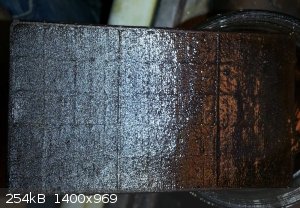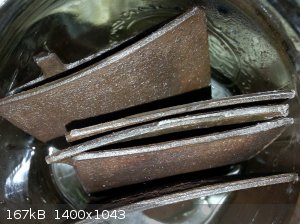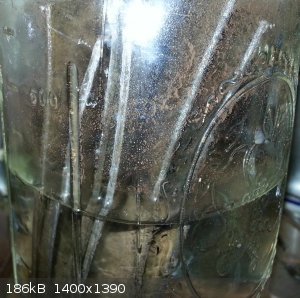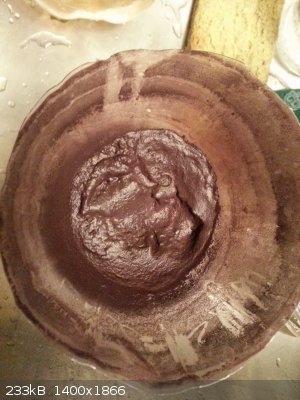RogueRose
International Hazard
    
Posts: 1585
Registered: 16-6-2014
Member Is Offline
|
|
Making PbO2 plates for chlorate production - from Pb lead-acid battery plates
Anyone who has taken apart a lead acid battery knows that the PbO2 plates ("red lead")are usually in pretty bad shape compared to the Pb plates as the
are often very brittle and have pieces falling off of them. I found recently that putting the good silver Pb plates (usually in good shape) in some
bleach turns them into nice red plates in good condition. I used 12.5% bleach but would suspect that using lower concentrate would work as well. I'm
not sure if there is a better oxidizer for this as I tried adding some H2O2 to the bleach and it instantly fizzes and when put on the red plates it
seems to erode the red coating.
From the How-to's I've read on chlorate cells, it says that if Pb plates are used, they will eventually oxidize to PbO2 but it can take some time and
the chlorate will be contaminated in the meantime.
The thing with the bleach is that it doesn't seem to penetrate the plate very far but I'm not sure that matters a whole lot for this process and may
even be better with a thin coating as it is much less brittle.
Can anyone shed any light on this?
|
|
|
Elemental Phosphorus
Hazard to Others
  
Posts: 184
Registered: 11-11-2016
Location: Is everything
Member Is Offline
Mood: No Mood
|
|
Lead dioxide is black or dark brown, and can be formed on lead by putting the lead in dilute sulfuric acid, as the anode, and applying ~1.5 volts. I
believe red lead is actually Pb3O4.
|
|
|
RogueRose
International Hazard
    
Posts: 1585
Registered: 16-6-2014
Member Is Offline
|
|
Quote: Originally posted by Elemental Phosphorus  | | Lead dioxide is black or dark brown, and can be formed on lead by putting the lead in dilute sulfuric acid, as the anode, and applying ~1.5 volts. I
believe red lead is actually Pb3O4. |
I believe you are correct. I'm still wondeirng what was made from the bleach. It starts off as rust color (and the bleach stays clear) but then
the metal turns the dark brown/black and the bleach starts to get contaminated.
I may try the electrolysis to see if there is a difference in color.
|
|
|
Elemental Phosphorus
Hazard to Others
  
Posts: 184
Registered: 11-11-2016
Location: Is everything
Member Is Offline
Mood: No Mood
|
|
Well, if the metal turns dark brown to black, that could be lead dioxide, no? I wouldn't be too surprised if hypochlorite could oxidize red lead oxide
to lead dioxide, it is an extremely strong oxidizer. You could scrape some of the black substance and test it by heating it very strongly and seeing
if it decomposes to red or yellow iron oxide.
|
|
|
RogueRose
International Hazard
    
Posts: 1585
Registered: 16-6-2014
Member Is Offline
|
|
Quote: Originally posted by Elemental Phosphorus  | | Well, if the metal turns dark brown to black, that could be lead dioxide, no? I wouldn't be too surprised if hypochlorite could oxidize red lead oxide
to lead dioxide, it is an extremely strong oxidizer. You could scrape some of the black substance and test it by heating it very strongly and seeing
if it decomposes to red or yellow iron oxide. |
Thanks, I'll try heating it and see if it decomp's
|
|
|
RogueRose
International Hazard
    
Posts: 1585
Registered: 16-6-2014
Member Is Offline
|
|
So I got some pics of the plates after they were in the bleach for about 24 hours, though they turned red/brownish immediately. I'll try a broken
plate and see if the bleach has penetrated completely or if this is more of a surface coating.
edit:: I checked the remaining bleach with a new plate and there was no reaction and it had no smell (bleach smell) either, so it looks like it is
penetrating the plates or it wouldn't have used up that much NaOCl as there was about 8 oz of 12.5%.
While the electrolysis while in H2SO4 isn't that difficult (though I'm not fond of setting up electrolysis), this is a pretty easy way to do it if
PbO2 needs to be made without too much hassle.
I also had some lead collected from the broken plates (the PbO2 plates that are a mix of red, brown and black - I think it depends upon the charge of
the battery when it is taken apart). The last pic of the lead paste is the lead from these plates that I placed in bleach. It looks more black when
viewed by eye but the flash really reflects the red spectrum of the oxide.
   
[Edited on 13-10-2017 by RogueRose]
|
|
|